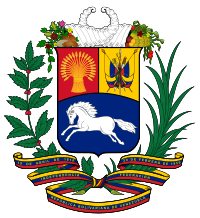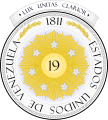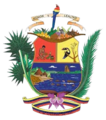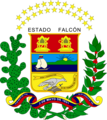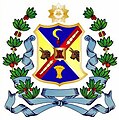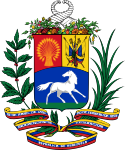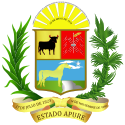Herb Wenezueli
Herb Wenezueli został po raz pierwszy przyjęty 18 kwietnia 1836 roku i przeszedł od tamtego czasu drobne modyfikacje.
Oficjalnie zatwierdzono go 17 lutego 1954 roku. Tarcza herbowa jest podzielona na trzy pola w kolorach flagi narodowej. W lewym górnym polu pszenica na czerwonym tle symbolizuje jedność 20 stanów Wenezueli. W prawym górnym polu miecz, szabla i trzy lance są połączone wieńcem laurowym z dwiema flagami narodowymi. W dolnym polu, na niebieskim tle przedstawiono biegnącego białego dzikiego konia będącego symbolem niepodległości i wolności.
Nad tarczą znajdują się dwa rogi obfitości symbolizujące bogactwo, a wokół niej znajduje się gałązka oliwna oraz liść palmowy. Na dole znajduje się wstęga w kolorach flagi narodowej z napisem: 19 de Abril de 1810 Independencia, 20 de Febrero de 1859 Federación, República Bolivariana de Venezuela (z hiszp. „19 kwietnia 1810 Niepodległość, 20 lutego 1859 Federacja, Boliwariańska Republika Wenezueli”).
W marcu 2006 roku Zgromadzenie Narodowe wprowadziło niewielkie modyfikacje w dotychczasowym herbie. Głównymi różnicami są zmiana kierunku biegu konia oraz dodanie w napisie na wstędze słowa „Boliwariańska” (Bolivariana).
Historia
Herb rodziny Welserów i ich koloni Klein-Venedig 1527-1546
Wielka Kolumbia 1819–1821
Stan Wenezueli 1830–1864
Herby stanów
Zobacz też
Media użyte na tej stronie
Coat of arms of Venezuela
Autor: Sparkve, Licencja: CC BY-SA 3.0
Escudo de los Estados Unidos de Venezuela, Confederación Venezolana o Provincias Unidas de Venezuela al momento de su independencia. Aparece por primera vez el 4 de julio de 1811 y fue elaborado por el Congreso Constituyente; previamente fue el símbolo que encabezó una declaración hecha por los comisionados legislativos de Caracas el 1 de julio de 1811. Su descripción heráldica se describe de la siguiente forma:
- El centro del escudo es un pequeño círculo, dentro del cual aparecen las cifras «19», recordando el 19 de abril de 1810; de todos los puntos de la circunferencia parten numerosísimos rayos de longitudes desiguales, aunque los más largos tienen todos la misma; el conjunto representa un sol, cuyo centro es el número 19. Alrededor de ese centro, a distancias iguales, hay 6 estrellas que se destacan sobre el fondo formado por los rayos.
- En la parte superior del conjunto hay una cinta o filacteria en la cual se lee la siguiente divisa latina: LUX UNITA CLARIOR, que podría traducirse así: «La luz concentrada es más brillante».
Autor: Milenioscuro, Licencja: CC BY-SA 3.0
Coat of arms of United Provinces of Venezuela (1811)
Autor: Wilfredor, Licencja: CC BY-SA 4.0
„
- Attributes.—
The Meridenian Coat of Arms presents a compound shape tierced per fess. The Quarter of the Chief enameled in Or (yellow) shows three panoplies: two swords crossed in saltire at dexter; a cannon with a mast with open sails at center and on the sinister an arrow crossed with a rifle rebounded by a Phrygian Cap, all in its colors. The Central Quarter enameled in Azure (blue) presents a snow crested mountain with a lake where a boat is sailing at dexter and a prairie at sinister with a Silver (white) horse running from dexter to sinister but looking to the dexter. The Quarter of the Base enameled in Gules (red) charges two bundles: one of sugar cane at dexter and one of wheat at sinister with a book and a flaming votive lamp in the middle. As external ornaments the blazon shows a condor in attitude of begin the flight crowned by a five-pointed star in Argent (Silver) as crest and as supports a coffee branch at the dexter and a laurel branch at the sinister jointed by means of an Argent pennant charging as mottoes the following inscriptions: "ESTADO MERIDA" ("Merida State") at the center; "9 DE OCTUBRE DE 1558" ("October 9th, 1558") at the dexter and "16 DE SEPTIEMBRE DE 1810" ("September 16th, 1810") at the sinister.
- Semiology.—
On the First Quarter the crossed swords reminds the triumph of the Spaniard founders of the city of Mérida over the so called tyrant Lope de Aguirre; the cannon and the mast with open sails represent the continuous fights against the pirates on Gibraltar harbor whilst the arrow, the rifle and the Phrygian Cap alludes to Battle of Niquitao won by Rivas Dávila and his Meridenian army on 1813. The Second Quarter it's a general semblance of the Meridenian landscape: its snowed crests, its lacustrian depression and its mountain foot looking to the prairies. The horse maintains the characteristic posture of that appear on the Coat of Arms of Venezuela and remember too the Liberty. On the Third Quarter the bundles of sugar cane and wheat reminds the agricultural riches of the State whilst the book and flaming lamp symbolizes the Meridenian intellectual tradition and the creation of its University. The enamels Or, Azure and Gules constitutes a tribute to the Venezolanity. The condor remembers the Andean roots of the region. The star symbolizes the Province of Mérida at the moment of its join to the national emancipation. The coffee branch reaffirm the agricultural tradition of the State and the laurel one reminds the triumph of the efforts of its sons and daughters. The mottoes rebound the regional identity, the date of foundation of the capital of the State and the date of the begin of the Independency Movement of Venezuela.”
Autor: CarBric76, Licencja: CC BY-SA 4.0
Regional emblem of the State Trujillo Venezuela, conducted in 1905 by journalist Br. Pompeyo Oliva.
Autor: Alfredosfloresp, Licencja: CC BY-SA 4.0
Escudo Estado Amazonas.
According to date Ordinance October of 1875, 20 the General Juan Alberto Ramírez, Constitutional governor of the the County of New Esparta, orders to adopt like Shield of this Political Entity, the one created by the civic D. Juan Manuel Velásquez Level and which appears in the Book Album of Shields of the States published in 1876.
- According to the heraldic lexicon it is denominated field the total surface and interior of a shield and barracks each one of the parts in that he/she is this divided. The Shield of the New State Esparta is divided in two barracks: red and blue.
- Emblems are the symbolic representations placed in the barracks of the shield. The Shield of New Esparta shows the attributes following emblematic: in the first barracks a flechera of gold appears on silver waves, and in the second a necklace of pearls.
- Ornaments are certain pieces that put on to accompany the main work. That of New Esparta has coral fields and of algae. A walks, a newt, an oar and connected trident.
- Stamp it is the badge that is placed above the Coat of arms to distinguish the grades of nobility. That of New Esparta has like bell, the cap frigio among rays of gold, and a laurel crown like symbol of their glorious victories in the Great Guerra of the good Emancipación.
Coat of arms of Venezuela (1954-2006)
Autor: Milenioscuro, Licencja: CC BY-SA 3.0
Coat of arms of Great Colombia (1819)
Escudo del Estado Carabobo
Autor: Nigu GD, Licencja: CC BY-SA 4.0
The coat of arms of the Venezuelan state of Guárico.
Autor: Milenioscuro, Licencja: CC BY-SA 3.0
Coat of arms of State of Venezuela (1830)
Autor: Autor nie został podany w rozpoznawalny automatycznie sposób. Założono, że to Andrés Urdaneta (w oparciu o szablon praw autorskich)., Licencja: CC-BY-SA-3.0
Autor: Julio Lopez Romero, Licencja: CC BY-SA 4.0
Coat of arms of Zulia state
Autor: Josedar, Licencja: CC BY-SA 4.0
Coat of arms of Delta amacuro
Autor: Josedar, Licencja: CC BY-SA 4.0
Coat of arms of Portuguesa State
Autor: Milenioscuro, Licencja: CC BY-SA 3.0
Coat of arms of Great Colombia (1821)
Autor: Samhanin, Licencja: CC BY 3.0
Coat of arms of Welser family (15th century - 16th century)
Autor: Nigu GD, Licencja: CC BY-SA 4.0
Coat of arms of the Venezuelan state of Monagas.
Autor: Josedar, Licencja: CC BY-SA 4.0
Escudo del estado Apure Venezuela (Vectorizado)
Escudo de Armas del Estado Anzoátegui
Fue decretado por el ejecutivo regional el 9 de septiembre de 1933 de acuerdo a la Ley de Escudo, Sello e Himno del estado Anzoátegui de 1876.
El escudo está dividido en dos cuarteles con los colores rojo y azul.
- El cuartel superior rojo contiene una fortaleza, que representa la Casa Fuerte de Barcelona, sobre la que se alza el ave fénix, símbolo de Venezuela, resurgiendo de las cenizas de la guerra. En ambos lados de la fortaleza, los eslabones de unas cadenas rotas simbolizan la independencia de España y la abolición de la esclavitud.
- El cuartel inferior azul muestra a un toro al trote hacia su derecha. Este animal representa la riqueza agropecuaria del Estado.
Las figuras exteriores del escudo son las siguientes:
- Detrás del escudo, está un sol naciente que muestra un rostro por encima del escudo, simboliza la situación de la entidad en territorio oriental. Los rayos de este sol salen hacia los lados del escudo de forma circular, y los mismos representan los municipios en los que estaba dividido el Estado.
- Detrás del escudo, pero delante del sol, se entrecruzan dos cañones de bronce, a los lados dos ramas de laurel. Estos simbolizan las glorias de los nacidos en el Estado durante la guerra de independencia.
- En la base del escudo, una cinta une los dos cañones. En esta, la inscripción «Tumba de sus tiranos» conmemora la Batalla de Urica, librada en el Estado y en la que murió el realista José Tomás Boves.
Autor: Ten obraz wektorowy zawiera elementy, które zostały zaczerpnięte lub zaadaptowane z tego pliku:, Licencja: CC BY-SA 3.0
Escudo de los Estados Unidos de Venezuela, 1871
Autor: Wilfredor, Licencja: CC BY-SA 3.0
Coat of arms of Carcacas City (Venezuela)
Autor: Julio Lopez Romero, Licencja: CC BY-SA 4.0
Coat of arms of Vargas state
Autor: Wilfredor, Licencja: CC BY-SA 4.0
Coat of arms of Sucre State
Autor: Unukalhai, Licencja: CC BY-SA 3.0
Escudo de la Confederación de Venezuela, de acuerdo a las especificaciones dadas por el Congreso Constituyente de Caracas del 29 de enero de 1812, y decretado oficialmente el 15 de febrero de 1812.
